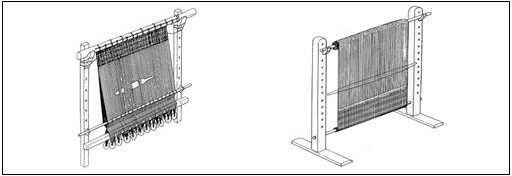Two Looms

Project start: November 2012.
This is a project that actually involves several different projects and entails different approaches that come together. The first objective is to build a functional warp weighted loom and subsequently, a functional two-beamed loom in order to test a series of hypotheses. Both looms will be built according to identical criteria.
|
Participating scholars |
Participating weavers |
|
|
Ellen Harlizius-Klück: objective is to weave different patterns in different techniques in order to study principles of technique and pattern connection. Further objective is to learn about constraints and possibilities of using patterned starting borders to organize structure and possible patterning of the fabric and to see how this task is solved on the two beam loom.
Ulrikka Mokdad: objective is to see whether it is possible to produce transparent textiles as depicted in the Theran wall paintings. She will test this using a set of reconstructed Minoan loom weights made at Lejre.
Hedvig Landenius Enegren: objective is to test reconstructed loom weights of diverse typology from three sites in S. Italy with regard to tension ranges and weave possibilities.
Giovanni Fanfani: objective is to test the functionality of implements like kairos and kanon in the warp-weighted loom in order to gain further insights into the poetic exploitation of weaving metaphors in Greek poetry.
Francesco Meo: objective is to test reconstructed loom weights from his site of study, Heraclea, S. Italy.
Eva Andersson Strand: objective is to learn more about the differences and similarities in techniques and weaving methods when using a warp weighted loom and a vertical two-beam loom.
Mary Harlow: objective is to explore toga weave.
Marie-Louise Nosch: objective is to test the sound of different types of loom weights during the weaving process on the warp-weighted loom.
Cecilie Brøns: objective is to test the functionality of pins and fibulas of different sizes and weights with various fabric qualities and fibres, and furthermore to trace wear in the fabric from fibulas and pins.
Timeline: Start with the warp-weighted loom and follow with the two-beamed loom.
